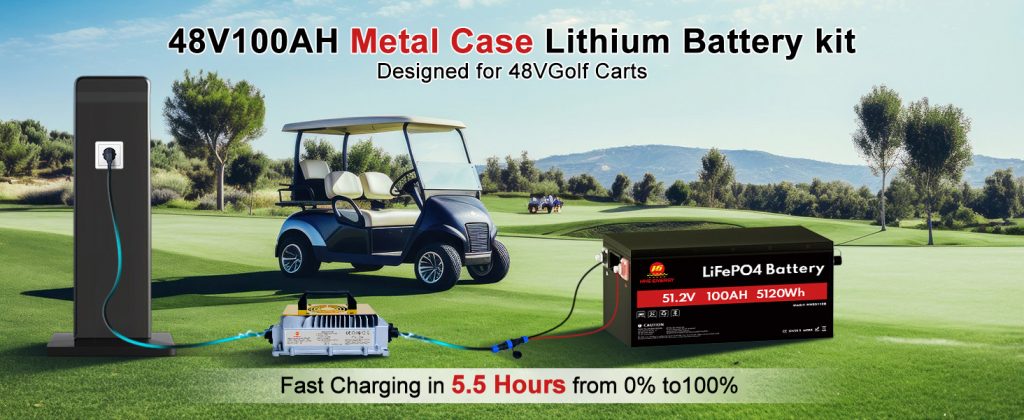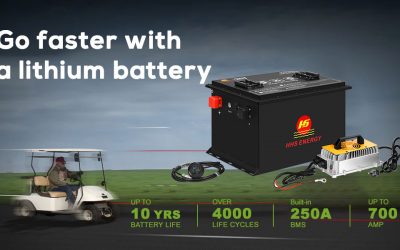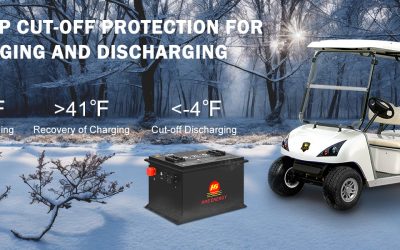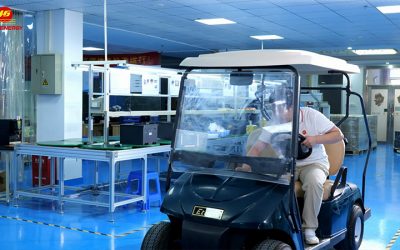Can You Put a Lithium Battery in Any Golf Cart?

Upgrading your golf cart’s power system can feel like giving it a brand-new life. As technology advances, lithium batteries have become the go-to power source for golf cart owners seeking longer range, faster charging, and less maintenance. But one question often comes up: Can you put a lithium battery in any golf cart?
The short answer is yes, in most cases — but it depends on compatibility, voltage configuration, and installation details. In this article, we’ll explore how lithium batteries fit into different golf cart models, what to consider before switching, and why brands like HHS ENERGY are making this upgrade easier and smarter than ever.
Understanding the Basics: Lithium vs. Lead-Acid Batteries
Traditional golf carts usually come with lead-acid batteries, known for their affordability but also for their heavy weight, long charging times, and short lifespan. Lithium batteries, on the other hand, are transforming the electric vehicle world — offering:
-
Higher energy density (more power in less space)
-
Faster charging
-
Longer lifespan
-
No maintenance
-
Consistent power delivery
When you swap out lead-acid for lithium, your golf cart gains better performance and range, while shedding unnecessary weight. The difference is often immediate — smoother acceleration, less sag on hills, and longer rides between charges.
Can Any Golf Cart Use a Lithium Battery?
In principle, yes — nearly all modern golf carts (Club Car, EZGO, Yamaha, etc.) can be converted to lithium power. However, there are key factors to ensure a safe and optimal installation:
1. Voltage Compatibility
Golf carts typically operate on 36V, 48V, or 72V systems.
When upgrading, the lithium battery pack you choose must match your cart’s voltage configuration. For instance:
-
36V systems → Use a 36V lithium battery pack
-
48V systems → Use a 48V lithium battery pack
-
72V systems → Use a 72V lithium battery pack
Brands like HHS ENERGY provide pre-configured LiFePO₄ battery packs designed to replace traditional setups without requiring extensive rewiring.
2. Battery Management System (BMS)
A high-quality BMS is the brain of a lithium battery. It regulates voltage, monitors temperature, prevents overcharging, and ensures each cell stays balanced.
Without it, your system risks damage or reduced performance. Always ensure the lithium pack includes a built-in BMS — as all HHS ENERGY lithium batteries do — for safety and reliability.
3. Charger Compatibility
You cannot use a standard lead-acid charger on a lithium battery. Lithium batteries require a dedicated charger designed to match the battery’s chemistry and voltage. Some brands, like HHS ENERGY, offer plug-and-play chargers that make the transition simple and safe.
4. Space and Mounting
Lithium batteries are more compact, meaning you’ll often free up space once you remove the bulky lead-acid set. This can even allow for additional storage or better weight distribution.
Why Switch to a Lithium Battery for Your Golf Cart?
The advantages of lithium over lead-acid are not subtle — they redefine your entire driving experience. Let’s break them down:
1. Weight Reduction
Lead-acid batteries can weigh 300–400 lbs. A lithium setup can be as light as 100 lbs, improving acceleration, hill-climbing ability, and even reducing tire wear.
2. Faster Charging
Lithium batteries can recharge fully in 2–3 hours, compared to 8–10 hours for lead-acid. That means less downtime and more time on the course.
3. Longer Lifespan
Lead-acid batteries typically last 2–3 years. Quality lithium packs — like HHS ENERGY LiFePO₄ batteries — can last 10 years or more, depending on usage.
4. Consistent Power Output
With lead-acid batteries, you feel a gradual drop in power as you discharge. Lithium batteries maintain peak voltage until nearly empty, giving you consistent torque and speed.
5. Maintenance-Free
No more adding water, checking acid levels, or cleaning corrosion. Lithium batteries require zero maintenance — just charge and go.
Common Myths About Lithium Golf Cart Batteries
Myth 1: Lithium batteries are too expensive.
While the upfront cost is higher, the long-term savings are substantial. Over 10 years, one lithium battery can replace multiple sets of lead-acid batteries — saving you money on replacements, maintenance, and electricity.
Myth 2: They’re unsafe.
Modern LiFePO₄ chemistry (used by HHS ENERGY) is extremely stable, resistant to overheating, and features multiple safety layers in the BMS. It’s one of the safest energy storage technologies available.
Myth 3: You have to modify your golf cart extensively.
Most conversions are straightforward. Many lithium packs are drop-in replacements that fit existing battery trays and connect to the original wiring.
How to Convert Your Golf Cart to Lithium Power
Here’s a step-by-step overview for converting your existing golf cart to lithium:
-
Identify your current system voltage (36V, 48V, or 72V).
-
Choose a compatible lithium battery pack — for example, HHS ENERGY 48V 105Ah LiFePO₄ Battery for 48V systems.
-
Remove the old lead-acid batteries and clean the battery compartment.
-
Install the lithium battery, securing it properly and connecting terminals according to polarity.
-
Install the lithium-compatible charger.
-
Test run the cart to ensure all systems operate smoothly.
Most conversions take less than a day and require minimal mechanical skill if you’re using a ready-to-install kit.
Real-World Example: Transforming a 48V Golf Cart
One customer recently upgraded a 48V Yamaha golf cart with a HHS ENERGY 48V 100Ah lithium battery pack. The results were immediate:
-
Range increased from 20 miles to 45+ miles per charge
-
Charging time dropped from 9 hours to 3 hours
-
Total weight reduced by 250 lbs
-
Acceleration felt noticeably smoother
The owner reported not only performance improvement but also reduced wear on the suspension and tires — a bonus few expect from a battery upgrade.
Environmental and Efficiency Benefits
Switching to lithium is also a win for the planet. LiFePO₄ batteries are non-toxic, fully recyclable, and have much higher energy efficiency — up to 95% round-trip efficiency, compared to 70–80% for lead-acid.
Less energy wasted in charging means lower electricity bills and smaller carbon footprints for golf courses and private users alike.
Choosing the Right Lithium Battery Brand
When selecting a lithium battery for your golf cart, look for:
-
Proven LiFePO₄ chemistry
-
Built-in Battery Management System (BMS)
-
High-quality cells with certifications (UL, CE, UN38.3)
-
Warranty and after-sales support
-
Compatibility with your cart’s voltage
Brands like HHS ENERGY design lithium golf cart batteries with all these in mind — delivering premium-grade cells, robust BMS protection, and smart charging solutions for 36V, 48V, and 72V models.
Final Thoughts
So, can you put a lithium battery in any golf cart? Yes — and you absolutely should. Whether you’re upgrading a classic 36V Club Car or a modern 72V electric buggy, lithium batteries bring performance, longevity, and freedom from maintenance headaches.
By choosing a reliable provider like HHS ENERGY, you’re not just upgrading your battery — you’re upgrading your entire driving experience. Expect smoother rides, faster charging, and years of dependable performance.
Your golf cart deserves the best power behind every ride — and that power is lithium.





